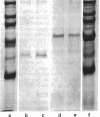Abstract
A glycoprotein binding complement component C3d was isolated from media used for culture of Raji human lymphoblastoid cells. Analysis by sodium dodecyl sulfate/polyacrylamide gel electrophoresis and gas/liquid chromatography indicated that the C3d-binding glycoprotein consisted of a single polypeptide chain with extensive intrachain disulfide bonds, a molecular weight of 72,000, and several different bound carbohydrates. Several lines of evidence indicated that this medium-derived C3d-binding protein originated from membrane complement receptor type two (CR2, the C3d receptor), presumably shed during membrane turnover. The C3d-binding protein bound to sheep erythrocytes coated with C3d (EC3d) but not to sheep erythrocytes coated with C3b (EC3b). Antisera, prepared by immunization with the purified C3d-binding glycoprotein, inhibited lymphocyte rosette formation with EC3d but not with EC3b. Analysis by sodium dodecyl sulfate gel electrophoresis of the radiolabeled and solubilized lymphocyte antigens reactive with the anti-C3d-binding protein sera revealed a single-chain cell-surface protein of molecular weight 72,000 that was apparently identical to the isolated C3d-binding protein. Parallel assay of lymphocytes for Cr2 by direct immunofluorescence with F(ab')2 anti-C3d-binding protein (anti-CR2) and rosette formation with EC3d indicated that both assays had the same specificity and nearly the same sensitivity. With both systems CR2 expression was limited to B cells, and was undetectable on T cells, monocytes, or neutrophils.
Full text
PDF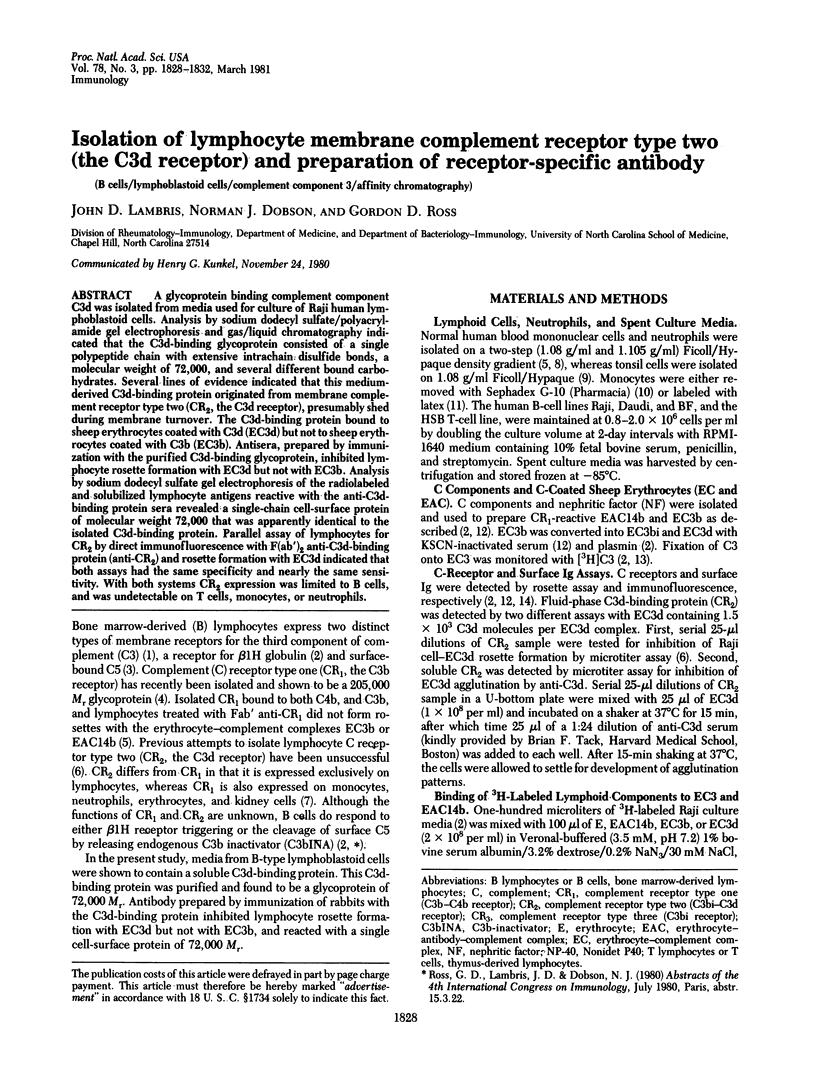
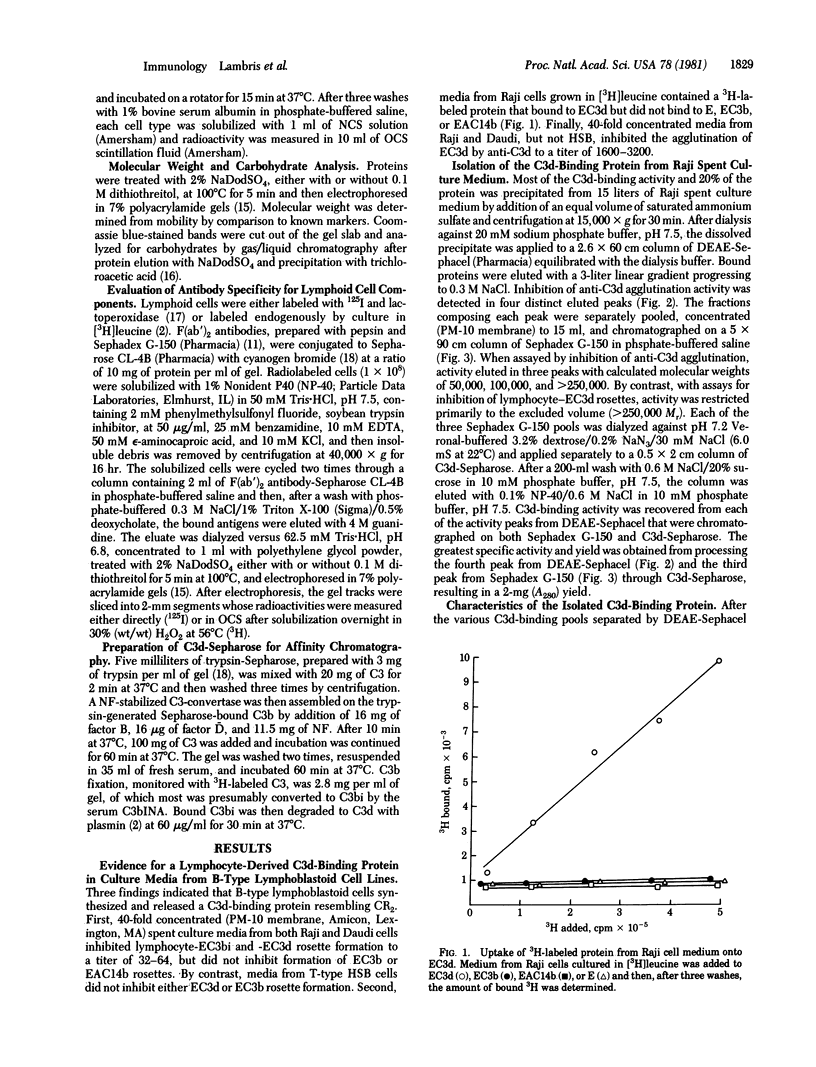
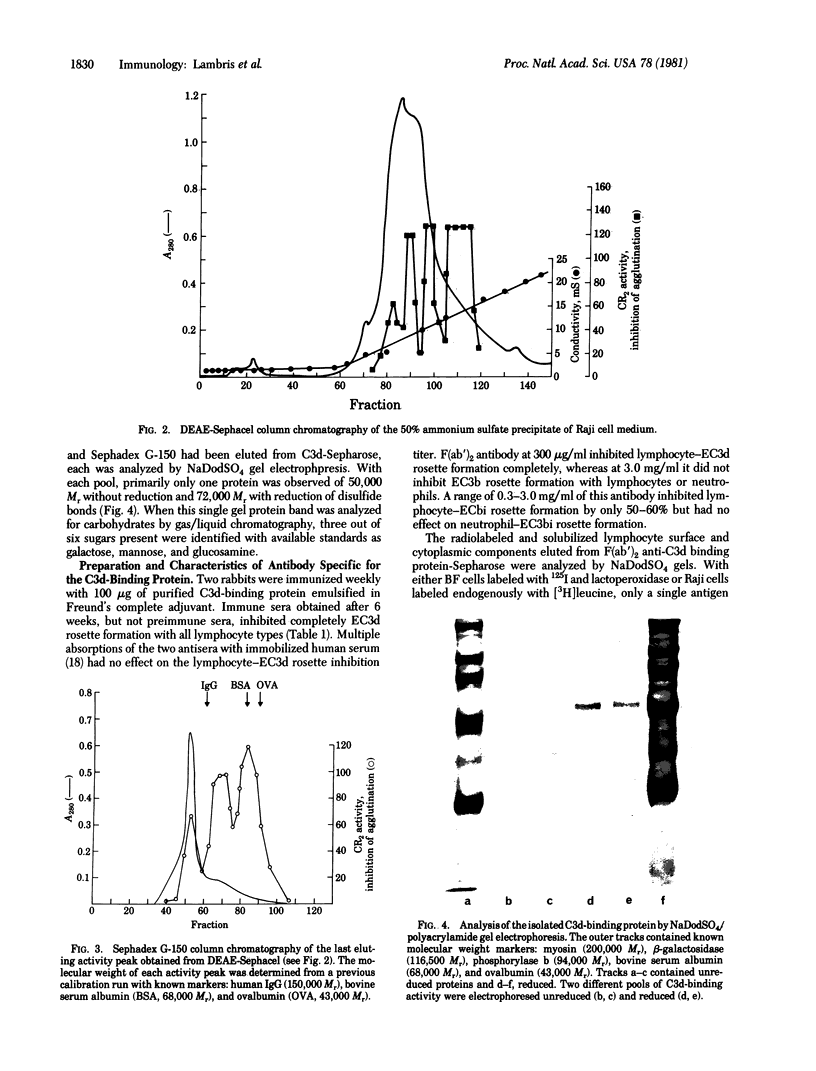
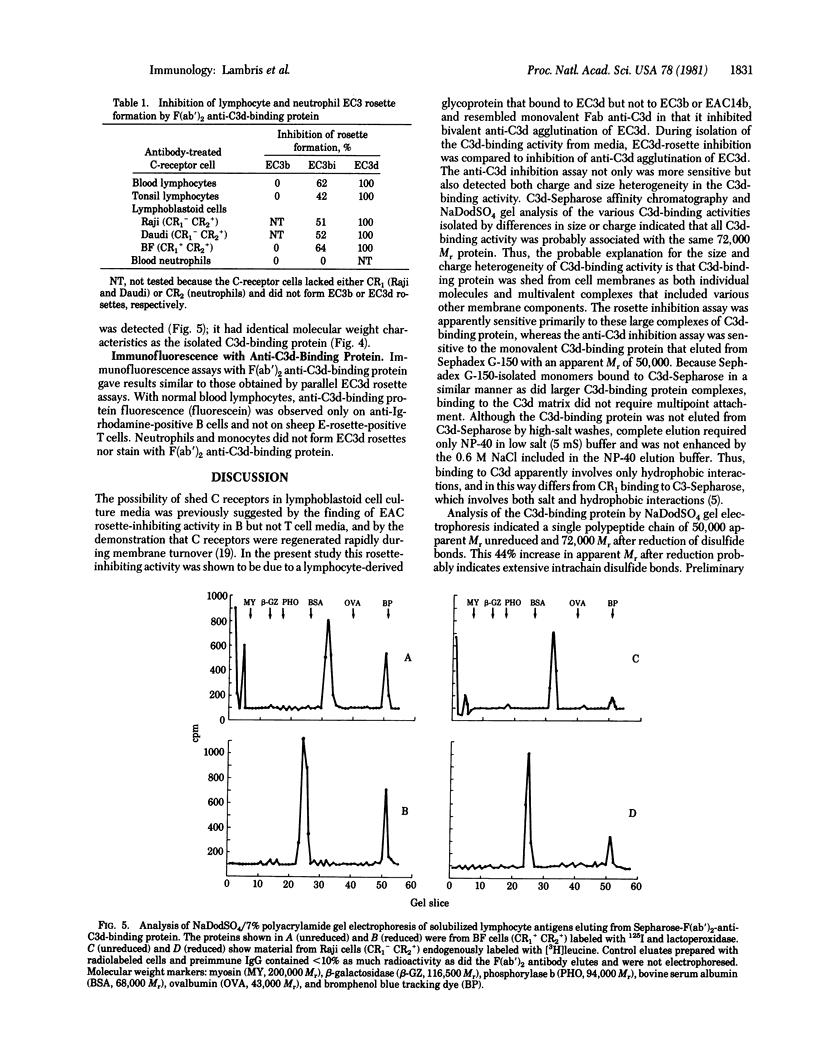
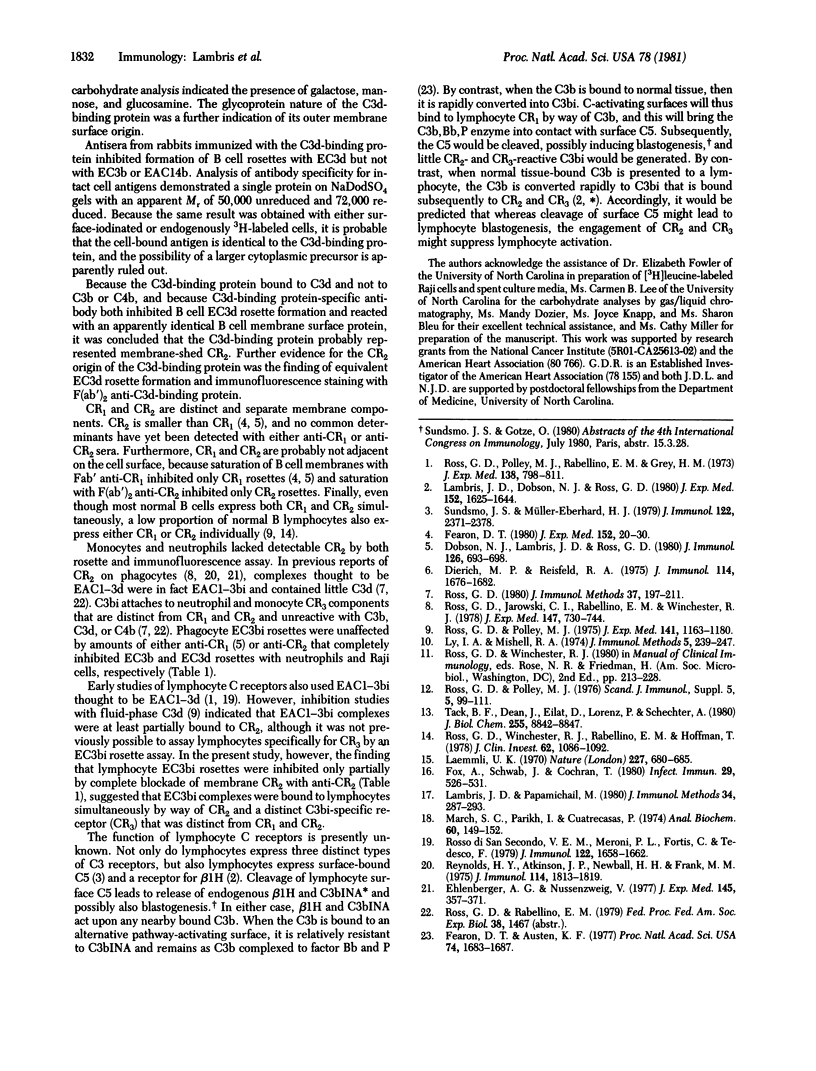
Images in this article
Selected References
These references are in PubMed. This may not be the complete list of references from this article.
- Dierich M. P., Reisfeld R. A. C3 receptors on lymphoid cells: isolation of active membrane fragments and solubilization of receptor complexes. J Immunol. 1975 Jun;114(6):1676–1682. [PubMed] [Google Scholar]
- Dobson N. J., Lambris J. D., Ross G. D. Characteristics of isolated erythrocyte complement receptor type one (CR1, C4b-C3b receptor) and CR1-specific antibodies. J Immunol. 1981 Feb;126(2):693–698. [PubMed] [Google Scholar]
- Ehlenberger A. G., Nussenzweig V. The role of membrane receptors for C3b and C3d in phagocytosis. J Exp Med. 1977 Feb 1;145(2):357–371. doi: 10.1084/jem.145.2.357. [DOI] [PMC free article] [PubMed] [Google Scholar]
- Fearon D. T., Austen K. F. Activation of the alternative complement pathway due to resistance of zymosan-bound amplification convertase to endogenous regulatory mechanisms. Proc Natl Acad Sci U S A. 1977 Apr;74(4):1683–1687. doi: 10.1073/pnas.74.4.1683. [DOI] [PMC free article] [PubMed] [Google Scholar]
- Fearon D. T. Identification of the membrane glycoprotein that is the C3b receptor of the human erythrocyte, polymorphonuclear leukocyte, B lymphocyte, and monocyte. J Exp Med. 1980 Jul 1;152(1):20–30. doi: 10.1084/jem.152.1.20. [DOI] [PMC free article] [PubMed] [Google Scholar]
- Fox A., Schwab J. H., Cochran T. Muramic acid detection in mammalian tissues by gas-liquid chromatography-mass spectrometry. Infect Immun. 1980 Aug;29(2):526–531. doi: 10.1128/iai.29.2.526-531.1980. [DOI] [PMC free article] [PubMed] [Google Scholar]
- Laemmli U. K. Cleavage of structural proteins during the assembly of the head of bacteriophage T4. Nature. 1970 Aug 15;227(5259):680–685. doi: 10.1038/227680a0. [DOI] [PubMed] [Google Scholar]
- Lambris J. D., Dobson N. J., Ross G. D. Release of endogenous C3b inactivator from lymphocytes in response to triggering membrane receptors for beta 1H globulin. J Exp Med. 1980 Dec 1;152(6):1625–1644. doi: 10.1084/jem.152.6.1625. [DOI] [PMC free article] [PubMed] [Google Scholar]
- Lambris J., Papamichail M. A method for analysing lymphocyte surface antigens. J Immunol Methods. 1980;34(4):287–293. doi: 10.1016/0022-1759(80)90101-5. [DOI] [PubMed] [Google Scholar]
- Ly I. A., Mishell R. I. Separation of mouse spleen cells by passage through columns of sephadex G-10. J Immunol Methods. 1974 Aug;5(3):239–247. doi: 10.1016/0022-1759(74)90108-2. [DOI] [PubMed] [Google Scholar]
- March S. C., Parikh I., Cuatrecasas P. A simplified method for cyanogen bromide activation of agarose for affinity chromatography. Anal Biochem. 1974 Jul;60(1):149–152. doi: 10.1016/0003-2697(74)90139-0. [DOI] [PubMed] [Google Scholar]
- Reynolds H. Y., Atkinson J. P., Newball H. H., Frank M. M. Receptors for immunoglobulin and complement on human alveolar macrophages. J Immunol. 1975 Jun;114(6):1813–1819. [PubMed] [Google Scholar]
- Ross G. D. Analysis of the different types of leukocyte membrane complement receptors and their interaction with the complement system. J Immunol Methods. 1980;37(3-4):197–211. doi: 10.1016/0022-1759(80)90307-5. [DOI] [PubMed] [Google Scholar]
- Ross G. D., Jarowski C. I., Rabellino E. M., Winchester R. J. The sequential appearance of Ia-like antigens and two different complement receptors during the maturation of human neutrophils. J Exp Med. 1978 Mar 1;147(3):730–744. doi: 10.1084/jem.147.3.730. [DOI] [PMC free article] [PubMed] [Google Scholar]
- Ross G. D., Polley M. J. Assay for the two different types of lymphocyte complement receptors. Scand J Immunol. 1976 Jun;Suppl 5:99–111. doi: 10.1111/j.1365-3083.1976.tb03861.x. [DOI] [PubMed] [Google Scholar]
- Ross G. D., Polley M. J., Rabellino E. M., Grey H. M. Two different complement receptors on human lymphocytes. One specific for C3b and one specific for C3b inactivator-cleaved C3b. J Exp Med. 1973 Oct 1;138(4):798–811. doi: 10.1084/jem.138.4.798. [DOI] [PMC free article] [PubMed] [Google Scholar]
- Ross G. D., Polley M. J. Specificity of human lymphocyte complement receptors. J Exp Med. 1975 May 1;141(5):1163–1180. doi: 10.1084/jem.141.5.1163. [DOI] [PMC free article] [PubMed] [Google Scholar]
- Ross G. D., Winchester R. J., Rabellino E. M., Hoffman T. Surface markers of complement receptor lymphocytes. J Clin Invest. 1978 Nov;62(5):1086–1092. doi: 10.1172/JCI109214. [DOI] [PMC free article] [PubMed] [Google Scholar]
- Rosso di San Secondo V. E., Meroni P. L., Fortis C., Tedesco F. Study on the turnover of the receptor for the third component of complement on human lymphoid cells. J Immunol. 1979 May;122(5):1658–1662. [PubMed] [Google Scholar]
- Sundsmo J. S., Müller-Eberhard H. J. Neoantigen of the complement membrane attack complex of cytotoxic human peripheral blood lymphocytes. J Immunol. 1979 Jun;122(6):2371–2378. [PubMed] [Google Scholar]
- Tack B. F., Dean J., Eilat D., Lorenz P. E., Schechter A. N. Tritium labeling of proteins to high specific radioactivity by reduction methylation. J Biol Chem. 1980 Sep 25;255(18):8842–8847. [PubMed] [Google Scholar]



